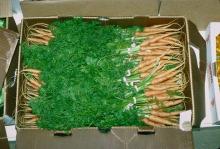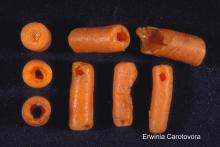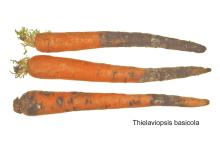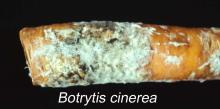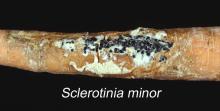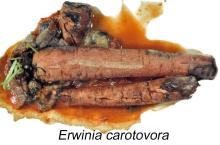Maturity and Quality
- In practice, harvest decisions for carrots are based on several criteria depending on the market outlet or sales endpoint
- Typically carrots are harvested at an immature state when the roots have achieved sufficient size to fill in the tip and develop a uniform taper
- Length may be used as a maturity index for harvest timing of ‘cut and peel' carrots to achieve a desired processing efficiency
There are many visual and organoleptic properties that differentiate the diverse varieties of carrots for fresh market and minimal processing. In general, carrots should be:
- Firm (not flacid or limp)
- Straight with a uniform taper from ‘shoulder' to ‘tip'
- Bright orange
- There should be little residual "hairiness" from lateral roots
- No "green shoulders" or "green core" from exposure to sunlight during the growth phase
- Low bitterness from terpenoid compounds
- High moisture content and high reducing sugars are most desireable for fresh consumption
U.S. Grades:
- Bunched Carrots - No. 1 and Commercial Grade
- Topped Carrots - Extra No. 1, U.S. No. 1, No. 1 Jumbo, No. 2
Quality Defects include lack of firmness, non-uniform shape, roughness, poor color, splitting or cracking, green core, sunburn, and poor quality of tops or trimming.
Postharvest Handling and Storage
0°C (32°F)
Storage life at 0°C is typically:
- Bunched: 10-14 days
- Immature roots: 4-6 weeks
- Mature roots: 7-9 months
- Fresh-cut (Lightly processed): 3-4 weeks
Common storage conditions rarely achieve the optimum temperature for long- term storage to prevent decay, sprouting, and wilting. At storage temperatures of 3-5°C, mature carrots can be stored with minimal decay for 3-5 months.
Common ‘Cello-pack' carrots are typically immature and may be stored successfully for 2-3 weeks at 3-5°C. Bunched carrots are highly perishable due to the presence of the shoots (tops). Good quality is generally maintained only for 8-12 days, even with contact ice.
Lighlty processed (fresh-cut, cut and peel) carrots typically maintain quality of 2-3 weeks at 3-5°C.
| Temperature | ml CO2/kg·hr | |
| °C (°F) | Topped | Bunched |
| 0 (32) | 5-10 | 9-18 |
| 5 (41) | 7-13 | 13-25 |
| 10 (50) | 10-21 | 16-31 |
| 15 (59) | 13-27 | 28-53 |
| 20 (68) | 23-48 | 44-60 |
| 25 (77) | NA | NA |
To calculate heat production multiply ml CO2/kg·hr by 440 to get Btu/ton/day or by 122 to get kcal/metric ton/day.
NA= Not applicable.
Exposure to ethylene will induce the development of bitter flavor due to isocoumarin formation. Exposure to as little as 0.5ppm exogenous ethylene will result in perceptible bitter flavor, within 2 weeks, at normal storage conditions. Thus, carrots should not be mixed with ethylene-producing commodities.
98-100%
High relative humidity is essential to prevent dessication and loss of crispness. Free moisture from the washing process or unevaporated condensation, common with plastic bin-liners (and due to fluctuating temperatures) will promote decay.
>0.1 µl/kg·hr at 20°C (68°F)
Controlled atmosphere is of limited use for carrots and does not extend postharvest life of carrots beyond that in air. CO2 concentrations above 5% have been shown to increase spoilage. Low oxygen concentrations, below 3%, are not well tolerated and generally results in increased bacterial rot.
Disorders
Intact Roots. Bruising, shatter-cracks and tip-breakage are signs of rough handling. Nantes-type carrots are particularly susceptible. Sprouting will continue as carrot roots develop new shoots after harvest. This is one reason low temperature postharvest management is critical. Common associated disorders include wilting, shriveling, or rubberiness due to dessication. White Root is a physiologic disorder due to suboptimal production conditions which results in patchy or streaks of low color on the carrot roots.
Intact or Fresh-cut. Bitterness may be caused by preharvest stress (improper irrigation scheduling) or exposure to ethylene from ripening rooms or mixing with commodities such as apples. Freezing injury will likely result at temperatures of -1.2°C ( 29.5°F) or lower. Frozen carrots generally exhibit an outer ring of water-soaked tissue, viewed in cross section, which blackens in 2-3 days.
Fresh-cut. White Blush, due to dehydration of cut or abrasion-peeled surfaces, has been a problem on fresh-cut carrots. Sharp cutting blades and residual free-moisture on the surface of the processed carrots will significantly delay the development of the disorder.
The most prominent postharvest disease concerns are Gray Mold (Botrytis rot) Watery Rot (Sclerotinia rot), Rhizopus rot, Bacterial Soft Rot, induced by Erwinia carotovora subsp. carotovora and Sour Rot (Geotrichum rot). Proper handling and low temperature storage and transportation conditions are the best methods to minimize losses.
Special Considerations
Rapid hydrocooling soon after harvest is strongly recommended.




